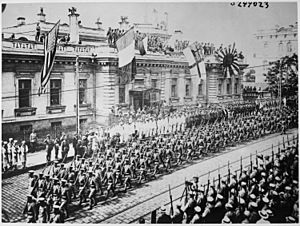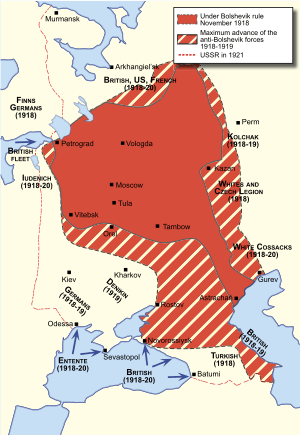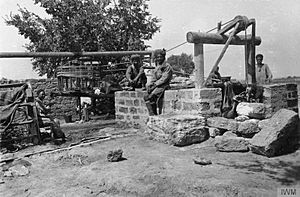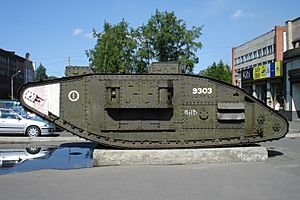Allied intervention in the Russian Civil War facts for kids
Quick facts for kids Allied intervention in the Russian Civil War |
|||||||
|---|---|---|---|---|---|---|---|
| Part of the Russian Civil War | |||||||
 Allied troops parading in Vladivostok, 1918 |
|||||||
|
|||||||
| Belligerents | |||||||
Allied Powers:
|
Bolsheviks:
|
||||||
| Commanders and leaders | |||||||
|
|
||||||
| Units involved | |||||||
| Strength | |||||||
|
Unknown | ||||||
| Casualties and losses | |||||||
|
Unknown 1 landing craft captured by Romanians |
||||||
The Allied intervention in the Russian Civil War was when several countries sent their military forces into Russia. This happened between 1918 and 1925. These countries, known as the Allies, included the United Kingdom, France, the United States, and Japan.
At first, their main goal was to help the Czechoslovak Legion. These were soldiers who wanted to get out of Russia. The Allies also wanted to stop Germany from using Russia's resources during World War I. They also aimed to support some Allied forces stuck in Russia after the Bolshevik Revolution.
Later, the Allies tried to help the "White" forces in the Russian Civil War. The White forces were fighting against the Bolsheviks, who had taken control of Russia. However, the Allies had different ideas about what they wanted to achieve. Many of their soldiers were also tired from World War I. Because of this, most Allied troops left Russia by 1920. Japan stayed until 1922, and even occupied part of Sakhalin until 1925.
Contents
Why the Allies Intervened in Russia
The Russian Revolution and Its Impact
In early 1917, Russia was facing many problems. People were unhappy with Tsar Nicholas II and the ongoing World War I. This led to the February Revolution in March 1917. The Tsar gave up his throne, and a new government, called the Russian Provisional Government, took over. This government promised to keep fighting Germany.
The Allied Powers, like the United States, had been sending supplies to Russia since 1914. These supplies arrived through ports like Arkhangelsk, Murmansk, and Vladivostok. When the US joined the war in April 1917, President Woodrow Wilson supported the new Russian government.
However, the war became very unpopular in Russia. Many soldiers left the army. The Bolshevik Party, led by Vladimir Lenin, gained more support. They promised "Peace, Bread, Land." In November 1917, the October Revolution happened. The Bolsheviks took power from the Provisional Government.
Russia Leaves World War I
In early 1918, German forces invaded Russia. They took over a lot of land. To stop the fighting, the new Bolshevik government signed the Treaty of Brest-Litovsk with Germany on March 3, 1918. This treaty officially ended Russia's part in World War I.
The Allied Powers felt betrayed by this. They thought Russia had abandoned them. They worried that German forces would now use Russia's resources. They also feared that the Bolsheviks might not be able to stop Germany. So, the Allies decided to help the "White" forces, who were enemies of the Bolsheviks. They also sent their own troops to Russia.
The Czechoslovak Legion's Role
The Czechoslovak Legion was a group of soldiers from the Austro-Hungarian Empire. They were prisoners of war in Russia. They wanted to create their own independent country. So, they joined the Russian army to fight against the Central Powers.
After Russia left the war, the Bolsheviks agreed to let the Czechoslovak Legion leave Russia. They were supposed to travel across Siberia by train to Vladivostok. From there, they would go to France to fight with the Allies. However, fighting broke out between the Legion and the Bolsheviks in May 1918. The Czechoslovak Legion ended up controlling much of the Trans-Siberian Railway and many cities in Siberia.
Allied Worries and Decisions
The Allies were very concerned. Russia had left the war, and their old ally, the Tsar, was gone. They worried about the huge amounts of supplies they had sent to Russia. They feared these supplies might fall into German hands. They also worried about German troops in Finland. These troops might try to capture important ports like Murmansk and Arkhangelsk.
The Allies also disliked the Bolsheviks' ideas, which worried many governments. British and French leaders decided to send troops to Russia. Interestingly, the first British troops landed in Murmansk because a local Bolshevik council asked for help. They feared a German attack.

The British and French asked the US to send soldiers. In July 1918, President Wilson agreed to send about 5,000 US Army troops to Arkhangelsk. Another 8,000 US soldiers were sent to Vladivostok. Canada also sent troops, as did Australia and India.
Japan sent the largest force, about 70,000 soldiers. They wanted to create a buffer state in Siberia. They also strongly disliked communism. Italy, Serbia, and China also sent smaller groups of soldiers.
Even though Soviet propaganda later said the Allies wanted to crush communism, most Allies were focused on World War I. They didn't want a long fight in Russia. Some, like Winston Churchill, strongly wanted to stop the Bolsheviks. But most Allied leaders were not as keen. The low number of Allied casualties shows that their involvement in fighting was limited.
Allied Forces Across Russia
Many foreign soldiers were present in different parts of Russia:
- About 14,378 British troops were in North Russia.
- Around 1,800 British troops were in Siberia.
- About 23,351 Greek soldiers were in Crimea and around Odessa.
- Around 15,000 French troops were in Southern Russia.
- About 40,000 British troops were in the Caucasus region by January 1919.
- Around 13,000 American troops were in Arkhangelsk and Vladivostok.
- About 11,500 Estonian troops were in northwestern Russia.
- Around 2,500 Italian troops were in Arkhangelsk and Siberia.
- About 70,000 Japanese soldiers were in the Eastern region.
- Around 4,192 Canadian soldiers were in Siberia, and 600 in Arkhangelsk.
- About 2,300 Chinese troops were in Vladivostok.
Key Campaigns and Battles
North Russia Campaign
The first British troops arrived in Murmansk in March 1918. They fought alongside Russian Red Guards against White Finns. This was before relations between the Allies and Bolsheviks became hostile. Later, Allied forces fought against Bolshevik attacks.
In August 1918, French and British troops occupied Arkhangelsk. They supported anti-Bolshevik forces there. American forces also arrived in September. They helped defend against Bolshevik attacks.
During the winter of 1918, fighting slowed down. But in January 1919, the Bolsheviks used poison gas shells against British positions. This was reported in the British press.
In February 1919, British forces in Murmansk tried to capture more areas to recruit White Russian soldiers. They captured the town of Segeja. However, the Allies faced strong resistance.
A key battle happened at Shenkursk in January 1919. British and Allied troops were forced to leave the city after heavy fighting. This was a turning point for the Allies in North Russia.
Many British and foreign troops became unwilling to fight. There were also mutinies among White Russian troops. This lowered the morale of Allied soldiers. Some Allied soldiers, including British, American, and Canadian troops, also rebelled.
By May and June 1919, many original British and French troops were sent home. All Canadian and American troops also left. The Allies had planned a new offensive to capture the city of Kotlas. But this plan was canceled when White forces were pushed back.
In July 1919, more White units mutinied. They killed their British officers and joined the Bolsheviks. The city of Onega was also handed over to the Bolsheviks by mutinying White troops. This made the British lose trust in the White forces. It also made them want to withdraw.
The last two months on the Dvina front saw fierce fighting. In August, the Allies launched an offensive. They captured several villages and took many prisoners. This was seen as a success.
By September 1919, British troops began to withdraw to Arkhangelsk. The last Allied troops left Arkhangelsk on September 27, 1919. Murmansk was abandoned on October 12.
Baltic and Northwestern Russia Campaign

The Estonian Army gained control of its country. They then invaded Russia to support the White Russian Northern Corps. The British Royal Navy helped them along the coast.
In December 1918, British warships captured two Bolshevik destroyers. These ships were given to the Estonian government. They became the start of the Estonian Navy.
In May 1919, the Estonian army attacked Pskov. They captured the town and cleared the area. White Russian forces then arrived in Pskov. Later, these White forces became the Northwestern Army.
British ships also attacked the Bolshevik naval base at Kronstadt. They sank some ships. However, a mutiny by Russian soldiers at a fort was eventually stopped by Bolshevik forces.
The Northwestern Army tried to capture Petrograd in October 1919. Britain and France provided weapons. The Estonian and British forces attacked. The Northwestern Army got very close to Petrograd. But the Red Army pushed them back. The British failed to achieve their goal of securing Petrograd for the Whites.
British sailors in the Baltic also had unrest. Some small mutinies happened. This was due to being tired from World War I, poor conditions, and Bolshevik propaganda.
Southern Russia and Ukraine Campaign
In December 1918, French troops landed in Odessa and Sevastopol. This was part of the intervention in Southern Russia. Their goal was to help General Anton Denikin's White Army fight the Bolsheviks. French, Greek, and Polish troops were mainly involved.
However, the morale of these troops was low. They wanted to go home. In March 1919, a local warlord named Nikifor Grigoriev joined the Bolsheviks. He attacked Allied-held cities like Kherson and Nikolaev. Allied troops were forced to evacuate by sea, leaving supplies behind.
By April 1919, Allied troops left Odessa. A major mutiny among French sailors also forced the withdrawal. The last Allied troops left Crimea on April 29, 1919.
General Pyotr Wrangel reorganized his White army in Crimea. But the situation worsened. He and his soldiers fled Russia on Allied ships in November 1920.
Caucasus Campaign

In 1917, a small Allied military mission called Dunsterforce was sent to Persia. It was made up of Australian, British, and Canadian troops. Their goal was to gather information and prevent German propaganda.
Later, Dunsterforce was ordered to protect the city of Baku and its oil fields. The British feared that the Ottoman Empire might capture Baku. If they did, they could transport troops across the Caspian Sea to Central Asia. This would threaten British-controlled India.
The British landed in Baku in August 1918. They faced a short but intense siege by Ottoman forces in September 1918. The British fought hard but were forced to withdraw. About 200 British soldiers were killed or wounded.
After the Ottoman Empire lost World War I, they withdrew their forces. In November 1918, a British force of 1,600 troops arrived in Baku. They also occupied Georgian cities like Tiflis and Batum. They protected the Baku-Batum railway, which connected the Black Sea and the Caspian Sea.
By January 1919, the British had 40,000 troops in the Caucasus. These troops were mainly for defense. They were withdrawn in the summer of 1919. The last British forces left Baku on August 24.
Trans-Caspian Campaign
The British were worried about German and Ottoman forces moving into Russian Central Asia. So, they intervened in the Trans-Caspian area in August 1918. General Wilfrid Malleson supported a local committee that had removed the Bolsheviks from the area.
British and Empire troops fought against the Bolsheviks. They had several battles, including at Dushak. The British forces caused heavy losses to the Bolsheviks.
By November 1918, the British had re-occupied Merv. However, the British government decided to withdraw the forces. The last troops left in April 1919.
What Happened After
The Allied intervention had a lasting impact. Some historians believe it made the White generals seem like "puppets." This helped the Bolsheviks appear more independent and patriotic. It also made former Imperial military leaders join the Bolsheviks. The intervention helped the Bolsheviks use it for their own propaganda.
Allied Troops Leave Russia
Most Allied Powers left Russia in 1920. The Japanese military stayed in the Russian Far East until 1922. They occupied northern Sakhalin until 1925. This was after an agreement where Japan agreed to leave.
Historians' Views
Some historians believe the intervention poisoned relations between East and West for a long time. It may have even contributed to the start of World War II and the Cold War. For Soviet leaders, it showed that Western powers wanted to destroy their government.
Historian Robert Maddox said the intervention "prolonged a bloody civil war." This cost many lives and caused huge damage to Russia.
However, historian John Thompson argues that the intervention did stop the spread of the Bolshevik revolution into central Europe. The countries there were able to recover enough to resist Bolshevism. But the intervention also left a legacy of fear and suspicion between Russia and other major powers.
Legacy of the Intervention
Later, Soviet propaganda often said the Allied intervention was a US military invasion. They often ignored or downplayed American efforts to help with the famine that saved millions of lives.
Winston Churchill, a strong supporter of stopping the Bolsheviks, often regretted that the Allies didn't crush the Soviet state early on. He believed it would have been a great blessing for humanity.
de:Russischer Bürgerkrieg#Intervention der Entente-Mächte
See also
 In Spanish: Intervención aliada en la Guerra civil rusa para niños
In Spanish: Intervención aliada en la Guerra civil rusa para niños



